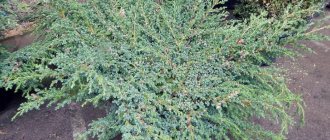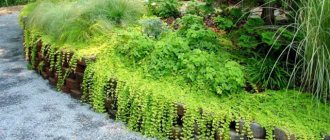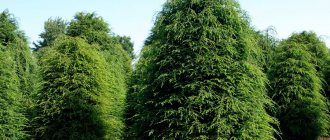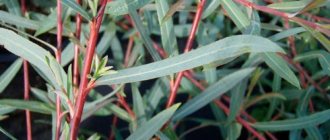Most people know only one tree called willow - the weeping willow. But in nature there are many different types of this plant, for example Matsudana willow. A photo of this beauty is now in front of you. Among its relatives, it stands out for its unusual beauty.
You will not see such twisted, twisted branches with silver-olive rolled leaves on any tree. Such decorative beauty is created not by human hands, but by nature itself. The color of the leaves changes with each season, thanks to which the garden in which this miracle of nature “lives” turns into a real fairy-tale place. If you decide to “settle” a tree such as Matsudana willow on your property, planting and caring for this plant will not be a very difficult task for you. And if you plant not one, but several garden beauties, then you can make a Japanese version; instead of the usual sakura in Japan, the Matsudana Japanese willow will delight you with its abundant and beautiful color.
Description of the twisting willow
The general description of the tortuous willow includes an important distinguishing feature - a curved trunk, branches and twisted narrow leaves.
The decorative shape of the branches contributes to the widespread use of the variety to create garden bonsai and original landscape compositions. Willow tolerates pruning well, which allows you to adjust the shape and density of the crown. Now we will look at the most common decorative varieties that are widely used in landscape design. Matsudana tortuous willow is very popular among gardeners. This is a medium-sized tree or bush, growing up to 4 - 13 m in height and up to 7 m in width. Its crown can be shaped as it grows, and it responds well to pruning. The leaves are narrow, oblong, 5–10 cm long, green above, blue or white below, wrapped in incomplete spirals.
https://www.youtube.com/watch?v=eprYbtcKRxs
The plant is very unpretentious, but for its good development it needs a lot of moisture and light. It should not be planted in a draft; the cold north wind has a particularly negative effect on it.
The Sverdlovsk sinuous willow of the Ural selection is better suited for our climate. The tree has a height of 2 - 4 m. The crown is oval or broadly oval, sometimes consisting of several thin trunks, of medium density, slightly weeping. Its spiral-shaped shoots of greenish-olive or red-brown color become glossy brown in the sun. The leaves are light green, slightly pubescent on top, and bluish below, moderately pubescent.
The Ural sinuous willow is relatively undemanding in terms of soil fertility. It loves light, so planting is recommended in open sunny areas with moist soil. The plant is highly frost-resistant and can easily withstand harsh winters. It is slightly affected by pests and fungal diseases and tolerates pruning well.
Varieties of Willow matsudana
- Willow matsudana Tortuosa. This tree is distinguished by its low growth, up to 3.5 m, its trunk is not too curved. Mature shoots grow straight, while new shoots hang down, forming a picturesque weeping shape. The leaves of this species of willow have a spiral shape. The disadvantage of this species is its low resistance to cold. The tree cannot withstand spring frosts and often freezes.
- Willow matsudana Erythroflexuosa. This variety is characterized by slow growth. The tree has a rounded crown, prone to thickening, which requires annual pruning. This willow grows up to 4-6 m in height. The shoots are intricately curved and yellowish in color. Frost resistance is even lower than that of Tortuosa willow.
Dwarf forms
In modern landscape design, several varieties of this tree are especially popular, but the most common type is brittle spherical willow, which is called broom. This tree can reach seven meters in height. The lush crown looks like a regular ball. The branches are quite fragile and can break from strong winds, but the fragility of the branches does not harm the aesthetic qualities of the tree, because the new growth increases the splendor of the crown.
The dwarf globular willow enjoys well-deserved popularity among landscape designers. The Purple Nana tree variety does not grow higher than one meter. Its dense crown has the shape of a regular ball. Graceful and finely pointed leaves grow on flexible and thin branches. The plant will fit perfectly into any garden and will look especially attractive in the spring, thanks to the purple color of the catkins.
If the area is small, it is better to plant dwarf spherical willow. It is represented by a slowly growing bush. Grows up to three meters. It has a thin trunk that often bends. The trunk is covered with cracks and has a thick bark. The leaves are small and soft green. Forms a beautiful lush crown in the form of a cap.
Young shoots are distinguished by the color of the foliage. They have a bright red color with a brown tint. Requires annual crown formation. To form a straight trunk, you need to remove excess branches. Pruning should be done before buds form, so as not to injure the plant.
It is also unpretentious, rarely gets sick, and tolerates frosts and severe frosts well. Dwarf trees are especially beautiful in single plantings. They can be planted near artificial ponds, on lawns and flower beds; they look beautiful around the house. It strengthens the soil well near reservoirs.
Loves sunlight, but also grows in shaded areas. In combination with other plants and bushes, you can decorate a Japanese-style garden using stones. Thanks to the fragrant peduncles, all plants are good honey plants. Willow is often planted near apiaries.
Types and varieties
The two most commonly grown species are the Matsudana tortuous willow (or Matsuda willow) and the Sverdlovskaya (Ural) tortuous willow.
Matsudana is, so to speak, an original. It was bred by Japanese breeders much earlier than the Ural variety, and became widespread throughout the world.
The most common matsudana variety is tortuosa. It grows into a small tree or tall bush up to 3.5 m high (occasionally up to 8 m). The trunk of this tree does not twist much. The skeletal branches are directed upward and more curved, and young thin shoots twist strongly and hang down, creating a moderately weeping crown.
The leaves are twisted into curls or spirals. The bark is gray, with a pistachio tint. Among the disadvantages of this variety, it should be noted that it has rather low frost resistance: in winter, a significant part of the plant above the level of snow cover can freeze out, and in spring, young leaves can be severely damaged by May frosts.
Erythroflexuosa is another variety of Matsudana tortuous willow, seedlings of which can occasionally be found in domestic nurseries and garden centers. However, it is less popular because it tolerates low temperatures and frost even worse.
Winding willows of the Ural (Sverdlovsk) selection are much more frost-resistant, while not inferior in beauty to Matsudana. There are several varieties of them (without names, under numbers), varying in size, shape and other characteristics. The most common are the following:
- No. 1 is a hardy tree about 4 m tall with a moderately weeping crown. It is distinguished by the reddish-brown color of its shoots, which look very impressive on a dormant tree without foliage. Has high frost resistance.
- No. 2 is a tall variety, reaches 12 m, with very twisting shoots. The bark color ranges from olive to brown, and the foliage is slightly hairy.
- No. 3 – up to 5m high. Interesting is the light olive bark, covered with a waxy coating that peels off a little. Less hardy than previous varieties, the top often dries out.
- No. 576 – low-growing variety, 2 – 3 m tall. Young shoots are red-brown, and adults are olive with a waxy coating, the crown is weeping.
Features of the plant
Depending on the varieties and formative pruning, curly willow can grow as a full-fledged shrub or tree with a height of three and a half to twelve meters. With good care and maintenance, as well as a favorable climate, a young tree grows by one to one and a half meters in height in the first two years, and then by about forty to sixty centimeters every year.
The unusual curly willow is distinguished by its high vitality, endurance, resistance to various diseases and pests, ease of care and reproduction, and undemandingness to the composition of the soil. Wood is very valuable from an environmental point of view, as it is able to cleanse the space around it, trapping dust and absorbing heavy metals. The healing properties of tortuous willow are used in folk medicine.
Decoctions, tinctures and teas from leaves, shoots and bark are used to normalize body temperature, improve hair quality, and also as an anti-inflammatory and tonic.
Bizarrely curved branches are the main decoration of this willow
- The height of the tree is up to 15 meters, width is up to 10 meters. But usually the trees are much smaller, they lend themselves well to pruning and forming small and neat crowns.
- The trunk and branches are intricately curved. Moreover, each tree has its own unique shape, which is not repeated. Due to the reddish bark, the branches stand out well against the green background.
- The plant tolerates winter well. But during severe frosts, young shoots freeze, but this is not a problem - in the spring they are quickly renewed.
- The trees are unpretentious in care. Even a novice gardener can handle the job; simple tips to follow are described below.
- Iwa Matsudana cannot tolerate shadows. Therefore, plant it in sunny areas or in places that are not in the shade for at least half the day.
Preparing for winter
Matsudana willow is considered winter-hardy, but young plants and those varieties that do not tolerate frost very well need shelter for the winter. It is recommended to insulate your green pets in October or the first half of November.
If, despite the efforts of the owner, the branched beauty froze in the winter, then you should not be too upset; after some time, with proper care and warm weather, the willow will recover and will again delight you with its beautiful appearance.
Willows for the Japanese garden
Recently, Japanese-style gardens have become increasingly popular, and spherical willows, which have a truly “Japanese” silhouette, fit perfectly into such a landscape and look no worse than sakura or pine. The Hakuro Nishiki variety attracts with white leaves on red-brown branches. The crown of the tree has the correct shape of a ball and reaches three meters in diameter. The variety is not frost-resistant and is suitable for the southern regions. In the northern regions, it is necessary to wrap the plant in winter.
Matsudana willow has the most suitable silhouette for a Japanese garden. Thanks to the weeping branches of an interesting twisting shape, this tree will fit perfectly into the landscape, and its curled leaves of silver-olive color will attract attention and add magic to the garden or park. Another advantage is that it grows quite quickly, about 50–60 cm per year.
Growing in open ground
In order for the Ural beauty to show all its decorative qualities, it is necessary to follow the rules of planting and caring for it. It doesn't require a lot of experience, hard work or a lot of time. Sunlight, moisture and fertilizing will turn a young seedling into a spectacular tree.
Landing dates
For seedlings with an open root system, the optimal time for planting is the dormant period. In spring it is March or early April, and in autumn it is the end of October, after the leaves fall. If the seedling is transferred to an open area along with a ball of earth, then you can choose any planting time - from mid-April to the end of October.
Selecting a location
Twisty willows, and especially the weeping species, prefer to grow in a well-lit sunny area without cold gusts of wind near a pond or in an area with close groundwater. A periodically flooded area is also perfect for the culture. The sun should heat and illuminate the tree from all sides, so it is not recommended to plant willow near buildings, tall trees or high-height fences. The soil should be light or medium loamy.
First you need to prepare planting holes measuring fifty centimeters in diameter and about thirty-five to forty centimeters in depth. On heavy soils, it is recommended to place a drainage layer about fifteen centimeters thick at the bottom of the hole. A mixture of broken bricks with river sand or expanded clay is suitable for drainage.
Growing conditions and care
- Willow is one of the few plants that will only benefit from proximity to groundwater. Therefore, if you have a pond or periodically flooded place on your site, feel free to place a willow there.
- Lighting should be plentiful, the willow should not be shaded by buildings or tall plants. In addition, proximity to a building or fence can cause uneven crown development.
- It is desirable to have protection from cold northern and northeastern winds, especially for non-frost-resistant varieties (Matsudan).
In principle, any soil will do - willow is unpretentious in this matter. But still, it will develop better on light or medium loamy soils.
Fertilizing is carried out 2 - 4 times a year, with complex mineral or organic fertilizers. It is extremely undesirable to apply nitrogen fertilizers after the beginning of August - this prevents the tree from entering a dormant state, which has an extremely negative effect on frost resistance.
Watering is necessary for young, recently planted plants, in the amount of 2 - 5 buckets per 1 tree, 2 - 4 times a month, depending on the size of the plant and the weather. The drought resistance of an adult tree depends on the area: if there is a pond nearby or the groundwater is shallow, the willow will obtain water on its own even in the driest periods, because its root system is quite deep and extensive. Otherwise, in clear hot summers, watering is necessary.
A hedge of globular willows
To create a cozy hedge that hides the yard or garden from prying eyes, you will need spherical willows of frost-resistant varieties. The ideal option would be Caspian or Ural willow. These low trees with a lush crown tolerate pruning well, so they can be used to form a fence of the required height and width.
Landing
- They dig holes measuring 50*50*50 cm. If you plan to plant many trees in a row, then it is advisable to dig a trench 50 cm deep and 50 cm wide.
- The seedling with closed roots is carefully removed from the container and placed in the middle of the hole.
- If the seedling has open roots, then pour a mound of soil into the middle of the hole, place the seedling in the center, and carefully straighten the roots.
- Cover the roots of the seedling with soil and gradually compact it to prevent the formation of air voids.
- Water the seedling and mulch the root zone with sawdust or other suitable material.
Basic rules of care
Fertilizer application
It is recommended to apply mineral and organic fertilizers two or four times throughout the season. A minimal amount of them is enough for a culture. Additional nutrition containing nitrogen only needs to be applied until the end of July. In the last month of summer, the willow is preparing to go into a dormant state, and nitrogen will prevent this.
After planting Sverdlovsk willow seedlings, daily abundant watering will be required for seven days, which will facilitate rapid establishment of the plant in a new location and the formation of new roots. Then watering is gradually reduced and carried out once or twice a week, and in the future two or three times a month will be enough. The average volume of irrigation water per week per tree is twenty-five liters.
The amount and frequency of watering also depend on weather conditions and the planting location. In an open, sunny area, it is recommended to use sprinkling, and in the shade, you only need to water the tree at the root. If groundwater or reservoirs are close, the volumes of irrigation water will be significantly smaller, since the willow itself will be able to provide itself with moisture from the soil.
Trimming
The decorative appearance of the Ural willow, as well as its full growth and development, depends on regular formative and sanitary pruning. Corrective pruning promotes the formation of new shoots and also improves the appearance of the tree by removing dead and damaged branches. The crop will be able to maintain its natural and well-groomed crown shape even with one pruning per year in the spring.
This decorative Ural species of willow is perfect for pruning and topiary. Topiary masters can turn a willow crown into a geometric figure, animal or any other object. Such natural sculptures will become a real decoration in the garden or in public recreation areas.
Winter insulation is especially necessary only for planted young trees that have not yet fully adapted to the open ground. The best covering would be spruce branches, which lie loosely and do not allow the bark to dry out.
This structure is located on the site from November to early March. Mature frost-resistant crops will survive the winter without shelter.
Mulching is also recommended for young trees. Mulch made from straw, chopped bark or sawdust is applied to tree trunk circles in early spring. This layer will protect crops that have not yet matured from weeds and will maintain moisture in the soil.
The tortuous willow is rarely affected by diseases and pests. The main pests are aphids, leaf beetles, caterpillars, spider mites, and rodents. The main disease is fungal spotting. It appears due to excess moisture in the form of numerous black dots on the leaves. Control measures include spraying with special preparations containing copper.
Results
To successfully grow matsudan willow, you need to pay special attention to the following care points:
- Select a landing site according to the recommendations.
- Choose healthy seedlings.
- Plant the seedlings according to the instructions.
- Promptly water, fertilize, weed, loosen and mulch.
- If diseases and pests are detected, take appropriate measures immediately.
- Cover young trees for the winter.
Sources:
https://fermerprofi.ru/2019/10/25/matsudana-posadka-ukhod-sort-eritrofleksuoza-tortuoza-foto-video/ https://glav-dacha.ru/pravila-posadki-i-ukhoda-za- ivoy-matsudana/ https://sornyakov.net/trees/iva-matsudana.html
How to plant globular willow
Before you start planting a tree, you need to choose the right place. The globular willow (the photo of which is shown) is quite sun-loving, but can also grow in shaded corners of the garden without losing its decorative appearance. This unpretentious plant takes root well in any type of soil. The only thing to consider is good soil moisture. If planting is not carried out on the shore of a reservoir, then the tree must be provided with regular and abundant watering.
It is better to plant shoots in early spring, before flowering, or in late autumn. You can mix a little humus into the planting hole, but it is better to carry out this procedure several days in advance - this way there will be no risk of burning the plant’s root system. To plant in heavy clay soil, it is necessary to create drainage from a 15 cm layer of sand. The tree can be buried below the root collar to a depth of 15 cm, this will create an additional lateral or adventitious root system.
Feeding curly willow
If you do not feed the curly willow, the tree will still delight you with its decorative appearance. If you want to “enrich” the soil in which willow grows, then consider the following recommendations for applying fertilizers;
- You can use any complex mineral fertilizer or organic matter as a top dressing;
- You should not feed the tortuous willow too often. 2-4 times per season is enough;
- Be careful when applying fertilizers that contain nitrogen. Stop using them during the last month of summer. Otherwise, it will be difficult for the tree to enter the dormant stage before winter.
We suggest you read: Is it possible for children to have pomegranate with seeds: at what age and in what form?
Reproduction methods
One of the simplest and most reliable methods of propagating Ural curly willow is cuttings. Rooting occurs easily and quickly both in water and in soil. As cuttings, you can use willow twigs that remain after pruning or cut new shoots. Each cutting is placed in moist soil to a depth of ten to fifteen centimeters and regularly moistened until the root system is formed.
Twisty willow can also reproduce by seeds, but this time-consuming and troublesome method is used only in breeding work.
Pruning curly willow
Pruning curly willow is an important element of care. The formation of shoots in willow occurs so quickly that even a single pruning will force you to carry out this procedure annually. It is for this reason that some gardeners are inclined to think that it is not necessary to form the crown of the tortuous willow at all, since the beautiful openwork crown of the tortuous willow is formed naturally. Let's look at the types of pruning that can still be applied to curly willow:
- Sanitary pruning is a type of pruning that can and should be applied to all varieties of curly willow, without exception. Pruning is carried out in early spring. It consists of removing broken, frozen shoots, which in the future will only spoil the appearance of the willow;
- corrective trimming. This type of pruning allows the curly willow to always look neat. To do this, every spring they inspect the crown and remove some shoots growing inside the crown, thickening it;
- formative pruning. This type of pruning is used when they want to significantly change the shape of the crown. Curly willow very quickly grows new shoots and is perfect for creating garden figures - topiary.
Some gardeners want to grow curly willow as a shrub. This can be achieved by annually cutting down the tree “under the stump”. This method is also suitable for growing varieties of willow that are not frost-hardy.
Caring for ornamental trees
A spherical willow can shade a gazebo or add sophistication to a garden; care for it will only be required in the initial stages, until the plant develops a powerful root system. It is especially important to take care of watering young trees, and to carry out sprinkling in the dry summer heat. In spring it is necessary to loosen the soil and get rid of weeds. Fertilizer made from peat would be useful.
Ball-shaped willows of less frost-resistant varieties need careful shelter in winter, and it is better to choose breathable materials for this. After the tree is strong enough, all care will be reduced to watering, especially in dry times, and pruning, which should be done before the buds appear in early spring. For pruning, pruning shears are used to remove dried shoots and branches that are out of shape.
Diseases and pests
Powdery mildew. Caused by the fungus Uncinula salicis Wint.
A white coating of mycelium appears on the affected leaves, which gradually grows and can cover the entire leaf blade. Later, round cleistocarps appear. The fungus undergoes the winter phase of development in the marsupial stage. The spores are oblong, measuring 26 - 32 X 10 - 11. It is common.
Control measures are the same as for oak powdery mildew.
Black leaf spot. Caused by the fungus Rhytisma salicinum Rehm., which forms small black shiny spots.
In spring, apothecia of elongated or round shape appear on the affected leaves. The bags are club-shaped, measuring 115-140 x X 8-15. If leaves are severely damaged, branches and young plants may die.
Control measures are the same as for other spots.
Application in landscape design
Willow shoots of unusual shape are often used in their work by florists and ikebana creators. In flower arrangements, this pliable and highly bendable material is an indispensable element. Due to their peculiarity, flexible shoots are also used in weaving. Masters of their craft skillfully transform ordinary willow twigs into vases, stands, dishes, boxes and other wicker interior items.
Most of all, this exotic plant is in demand and popular in landscape design. Summer cottages, gardens near the house, recreation areas where weeping willow or other decorative forms of the Sverdlovsk winding willow are planted have a more harmonious and complete image, creating the impression of complete unity between man and nature.
Weeping willow in landscape design is also used as a material for the construction of gazebos, living arches and hedges, tunnels and other architectural “structures”. Willow branches planted near various structures are periodically tied to them as they grow, and after some time a natural structure and an ideal resting place are formed. This ornamental plant looks great when planted alone or in a garden composition.
Choosing a place to plant curly willow
In order for the curly willow to decorate your site and to fully grow and develop, it is very important to choose the right place to plant this crop. Let's look at some recommendations for choosing a suitable location for a willow in your garden:
- Curly willows are excellent for strengthening banks and slopes. If there is a pond on your site, then a twisting willow will make it even more picturesque;
- to plant a twisting willow, you should choose a place that will be protected from drafts and strong gusts of north and northeast winds;
- To plant curly willow, choose a well-lit place. The tree should receive “sunbathing” from all sides. You should not plant willows close to a tall building that constantly creates shadow on one part of the tree. Such a willow can grow “one-sided”;
- When choosing a place to plant curly willow, you should take into account the location of other ornamental plants. Willows can be planted in group plantings with willows of other varieties, near other ornamental shrubs and plants;
- If on your site there is a periodically flooded place where not a single ornamental plant grows, then plant curly willow there. This tree grows well in this area. You can also plant willow in an area where groundwater flows close to the surface.
We invite you to familiarize yourself with Eleutherococcus berries preparation
Creating a willow garden
Ball willows, which are best propagated vegetatively, have gained a reputation as a plant that can take root even with one branch. The main condition is the presence of a sufficient amount of moisture. To get a tree with all the characteristics of the variety, thanks to which you can easily form a crown, you will need annual cuttings. To create a hedge, it is better to take branches older than two years.
For propagation, you need to cut branches immediately before rooting to a length of 30 cm. It is more advisable to carry out the procedure in the spring, in this case there will be no need to save the cuttings in the winter. There must be at least 5 buds on the workpiece. The upper cut should be made straight, and the lower cut oblique and under the bud.
Another method of propagation is to root the plant in water. To do this, you need to cut off the shoots at the beginning of the swelling of the buds and place them in a bowl of water. You can stimulate the process by making cuts on the bark with a sharp knife. When the roots appear, it is necessary to transplant the cuttings into nutrient soil, preferably to a permanent place.
Properly care for willow
Nursery specialists talk about the rules of care
- Trim branches in early spring , when the buds have not yet opened and sap flow has not begun. Then in the summer you will only have to do cosmetic pruning and the tree will be minimally injured.
- Treat willow every spring and fall with anti-fungal agents . They are the ones that most often infect this variety, and if preventive spraying is carried out, the willow will not get sick.
- Do not tie branches or place supports under them . This causes them to dry out, all corrective measures are carried out through pruning, it is with its help that the shape of the crown is formed.
Video
Some interesting facts about the plant
The globular willow (photo of its flowering is shown below) not only has a beautiful decorative appearance, but is known for many useful properties. In ancient times, a decoction of it was used to treat fever. And aspirin was extracted from the bark, without which it is impossible to imagine the life of modern man. The healing properties of willow-based preparations for the prevention of cancer are also known.
The bark and flexible branches of the tree have been used for household needs since ancient times, and to this day wicker furniture is made from willow vines, and the wood is used as a building material. The willow is the first to bloom in the spring, so the branches with their blossoming buds are used on Palm Sunday.
Thanks to its beauty and unpretentiousness, willow will become an exquisite decoration of any park or garden and will delight you with its impeccable appearance all year round. In the spring, this plant will delight you with lush and beautiful flowering, and in the summer it will provide shade. In winter, the beauty of the shiny dark brown bark and the bizarre silhouette under the snow cap will not leave you indifferent.
Useful properties of willow
- antipyretics,
- anti-inflammatory,
- diuretics,
- anthelmintic.
In addition to being decorative, matsudana willow also has various beneficial qualities. Willow bark is characterized by antipyretic properties due to the presence of acetylsalicylic acid in it. Willow bark contains the well-known salicylic acid, from which aspirin was later produced. And also has anti-inflammatory, diuretic, anthelmintic effects.
Tea made from willow leaves will help relieve fatigue ; you can also make a broom from branches for a bath, which is used to treat osteochondrosis and gout. The quinine it contains is an excellent remedy against malaria. And also positive results were observed in the treatment of gastrointestinal diseases and diarrhea.
Willow can be used externally, for example, for gargling, for varicose veins, sweating feet, and skin diseases. An infusion of the bark also helps weak and brittle hair. Willow also has a useful feature of absorbing heavy metals, which makes it possible to clear contaminated areas. With the help of experiments, it was proven that willow is one of the best plants that traps dust. A full-fledged tree can retain up to thirty-eight kilograms of dust.











